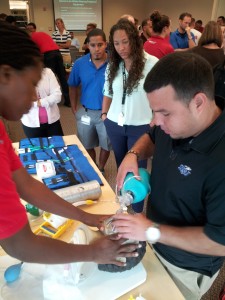NSU Newsroom
SharkBytes
Horizons
This version of NSU News has been archived as of February 28, 2019. To search through archived articles, visit nova.edu/search. To access the new version of NSU News, visit news.nova.edu.
This version of SharkBytes has been archived as of February 28, 2019. To search through archived articles, visit nova.edu/search. To access the new version of SharkBytes, visit sharkbytes.nova.edu.
Farquhar College of Arts and Sciences Hosts Workshop for Local Athletic Training Preceptors
Faculty members from NSU’s Athletic Training Education Program, housed within the Farquhar College of Arts and Sciences, hosted a free, on-campus preceptor workshop on Aug. 3. Preceptors are medical professionals who supervise athletic training students during their clinical practicums.
Co-sponsored by Broward Health’s division of Orthopedic Sports Medicine, the event brought together dozens of local athletic trainers and medical experts for a day of informative meetings and hands-on training.
“The overall goal of the workshop was to provide an opportunity for our preceptors to meet and discuss current concepts and trends in athletic training,” said Pradeep Vanguri, Ph.D., associate professor and coordinator of athletic training at clinical site in the college, who helped organize the workshop.
Also speaking at the event were college faculty members Megan Colas, Ph.D., assistant professor, and Elizabeth Swann, Ph.D., ATC, associate professor and athletic training program director.
Presentations covered a broad range of topics in physical and psychological health, from knee pain to concussions. Paramedics were also on hand to teach participants how to administer oxygen to patients.
Dustin Gatens, an NSU athletic trainer who works with the women’s soccer team and men’s basketball team, led a workshop on injury tracking and evidence-based practice. “One of the most important components of our jobs as athletic trainers is documentation, tracking what we do,” said Gatens after his presentation.
Gatens’ workshop focused on creating a cost-effective database to keep track of athletes’ injuries and other pertinent information. By documenting the date, type, and severity of athletes’ injuries in a simple spreadsheet, trainers can easily access and study the data. This not only provides records of a patient’s medical history, said Gatens, but it can also help better train and treat each individual athlete.
